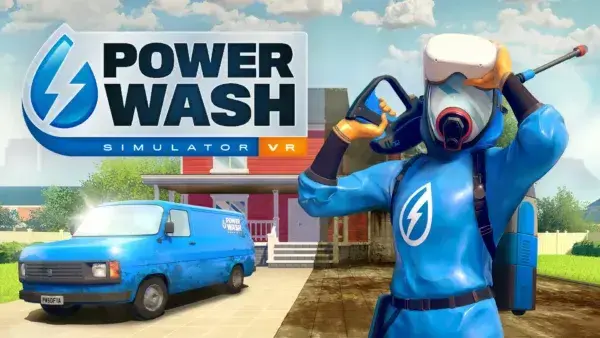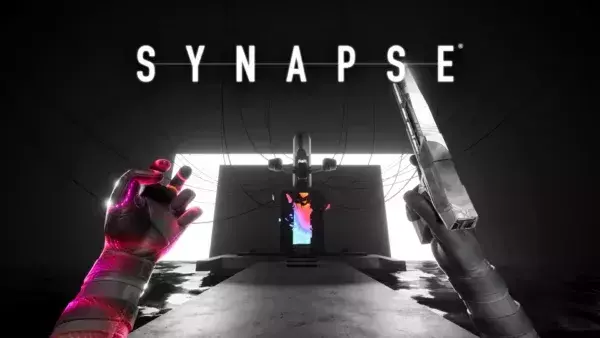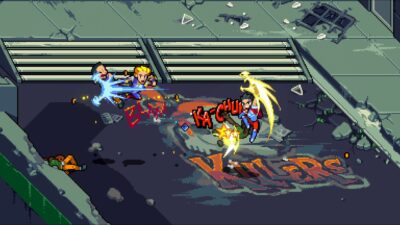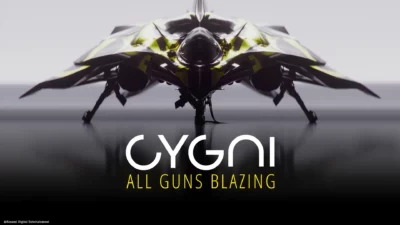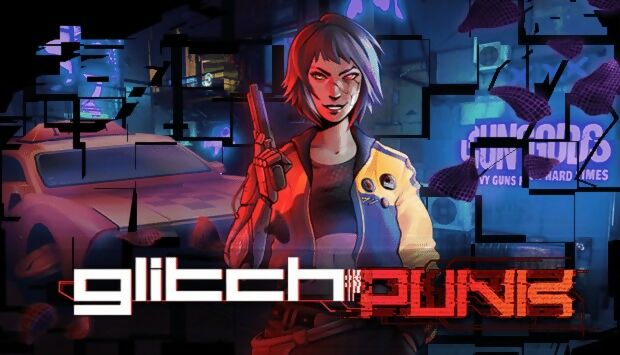
Polish game designer Maciej Karbownik positively buzzes with ideas. As we chat over Skype, the enthusiasm he has for his grim, cyberpunk world is infectious: he talks at breakneck speed about the dark motivations that drive his cast of characters; the unexpected real-world influences behind some of his mission ideas, and how he has enough snippets of story and notes to fill a sequel, or perhaps a novel. The influence of Grand Theft Auto 2 looms large in Glitchpunk, the debut game from Karbownik’s fledgling studio Dark Lord, but it’s clear he has more ambitious plans than a straight retread of that top-down crime classic.
Glitchpunk takes place in a familiar future of heartless corporations, cybernetic body modifications, and benighted city streets. As an android navigating your way through this gloomy landscape, you’re tasked with completing increasingly violent missions in exchange for cash and upgrades, while at the same time staying one step ahead of the law. It’s a crime sandbox with all the mayhem and car theft you’d expect, but in Karbownik’s telling, there’s a deeper story here if you’re looking for it. One NPC is seeking revenge for something dreadful that happened to him when he was a youth; there’s a mission where you’re asked to kill one of your allies and somehow make it look like an accident. Meanwhile, humanity’s sliding towards oblivion: AI is taking over, and as you progress from city to city, you’ll see the balance of power slowly shift from human to machine.

According to Karbownik, development on Glitchpunk is around 50 percent complete
It’s intriguing-sounding stuff, and the scale of what Dark Lord is attempting is all the more impressive given the size of the studio: this sprawling cyberpunk sandbox is essentially the work of just three developers. Here, then, is Karbownik himself to tell us the secret of making a cross between GTA 2 and Blade Runner on an indie budget…
So, if we just start at the beginning, and just sort of talk about how the game got started – this is Dark Lord’s first game, isn’t it?
Maciej Karbownik: Yeah. The company started off as a freelance studio with just me – a one-man company, basically. But then at some point, I was like, I’m so tired of B2B corporate bullshit. I wanted to make games from the start, but I ended up making B2B stuff, mostly. So I decided to take a shot, arrange a team of my friends, get some new people. And around the end of 2019, we started making a prototype. That’s how I started.

Screenshot 2021-06-15 at 14.04.01
Right. So did you want to make a top-down crime game primarily, or did the cyberpunk theme come first?
When I decided I wanted to go back to making games, I took a look at the indie market – what type of games are in that space – and then overlapped those with the things I would love to make myself. At that point, there weren’t many games inspired by the classic, top-down GTA and GTA 2. I thought, well, that’s a game from my childhood, so let’s go with it. So it was a cross between a passion project I was interested in doing, and at the same time seeing what’s feasible and makes sense from a business point of view.

Glitchpunk makes ingenious use of pre-made, kit-bashed 3D assets, allowing the team to make an entire city with relative ease
Glitchpunk is quite specifically influenced by GTA 2. Do you think it’s a bit of an underrated game, in a way? It didn’t have the controversy of the first or the leap to trendy 3D of GTA III.
Yeah, it’s interesting, because I was looking at it through nostalgia glasses, to be honest. But then I played it again recently and I actually still like it. But my friends have said that GTA 2 is basically the stinky kid of the series – everybody likes the first game, and then the later ones, but not the second one. I never felt like that – I always felt like this is the proper top-down GTA. The first one was kind of a rough prototype and looks terribly ugly to me. But GTA 2 is like the first game, but made the proper way. I enjoyed the simplicity of it, and at the same time, the level of polish – the audio-visual fidelity that was feasible for the development at that moment in time.
So, looking at GTA 2 through my lens of a developer with six years of professional experience at this point, I felt, like, that’s something we’re able to achieve – and hopefully add something more to it. It makes sense to go this route instead of, say, the next game in the series, GTA III, because it’s a completely different, much more complicated project.

If in doubt, toast it
What are the advantages of having a game viewed from top-down rather than say, full 3D or even isometric?
Technically speaking, the game is still fully 3D. Some elements, like cars and characters and other objects, are sprites. But we still have a traditional 3D workflow for building cities… The top-down perspective makes stuff a bit easier, for sure. Having the camera far up, away from everything, allows us to not focus so much on details that would be absolutely crucial in a modern game. Unless we did some unusual stylisation, which is also a challenge in itself. Because we’re a small team – at the core of the production, it’s three people. There’s me, another programmer, and our artist.

There’s a compelling story in Glitchpunk, but if you just want to steal cars and wreak havoc, that’s all here, too
So that top-down viewpoint aside, what other techniques do you use to create the illusion of a much larger city?
We don’t actually have a 3D artist, which might sound a bit surprising. I try to get as many resources as I can – 3D models, sounds, other assets – from different marketplaces, and then I try to mix it all together. I try to use them to speed up the workflow as much as possible, so we don’t create our 3D assets. I get a bunch of those asset packs, and I change them around by modifying them a bit in Blender. Then I add other materials, which makes them look completely different. All those assets are probably used in other games, but the top-down perspective makes them look so different. When you look at them from the top-down – which almost no other games do right now – it makes them even more difficult to recognise. So we use this approach of kitbashing pre-built assets wherever we can, because we can then put them in this cyberpunk universe of stories and characters, which is obviously 100 percent done by us.

Screenshot 2021-06-15 at 14.05.49
It’s interesting, because sci-fi movies have used kitbashing in one way or another for decades. Star Wars took pre-existing model kits and reworked them into spaceships.
It’s absolutely similar. Like Blade Runner’s scenery. I absolutely love it.
Yeah. Blade Runner took existing sets and then dressed them to look futuristic.
I like the quote from Pablo Picasso, which I’ll paraphrase – steal from one artist, and you’re a thief; steal from 50 of them, mix it, and then you’re an artist again. That’s how I approach it.
Did you look at much sci-fi, cyberpunk cinema when making the game? Blade Runner, Akira, that kind of thing?
You just mentioned most of them! But I’d add Ghost in the Shell. So yeah, I had to do my homework, which wasn’t so hard, because I was interested from the start. When I find something, I’m totally obsessed with it for months on end. I like reading books on it. I’m watching interviews. I’m watching the movie ten times in the background when I work, to kind of get the mood and just keep motivated.
As for games, I think there’s also two major titles beyond GTA 2. There’s Ruiner, from the Polish studio Reikon Games, which is absolutely fantastic. The game’s a bit more linear, with a fighting focus. That wasn’t really our thing, so we hope we won’t be called copycats, but the audio-visual style in Ruiner is absolutely fantastic. It’s a big influence on us. And then at the same time, there’s Hotline Miami.
To be honest, we used it because when I (mention) GTA 2 as a reference, some people get it – people who like playing more old-school games – but kids don’t really get it.
So I was like, ‘OK, let’s say it’s like Hotline Miami, with cars and with the open city’, which means basically GTA 2, in a way… And this kind of clicked and people went, ‘Oh yeah, this game looks like Hotline Miami’. But a lot of the stuff is actually in the game from 1999, GTA 2. But it was refreshing to them, because they only knew Hotline Miami – they didn’t know GTA 2.

Each city in Glitchpunk will be markedly different; “Everything changes, and everything gets progressively harder,” Karbownik says
I don’t know if you’ve played Syndicate, but the android modifications in Glitchpunk immediately made me go, ‘Ooh, this looks like Syndicate’.
Yeah. Living in Poland, we didn’t have so much modern tech until, like 2005, 2010. So I remember being a small kid with really, really, slow, bad computers, so I played old games, and one of those was Syndicate. I didn’t spend so much time with it, but I really enjoyed it – it was kind of a bit too hardcore for a six-year-old gamer!
But I think this kind of thing – corporations, body modifications, violent deaths, shady business – always influenced me… so Syndicate is a very distant inspiration. You can most certainly see some similarities in it.
It seems to me there are three things to balance – narrative, world design, and missions. So how do you make all of those mesh together nicely?
When I designed the story outline, I tried to use scripting techniques that have been around for a long time. There’s Blake Snyder, who wrote a book called Save the Cat. In it, he basically made a formula for how 90 percent of successful Hollywood movies go. So I looked into that and I was like, ‘Wow, I wish I knew that years ago when I started making games’.
And then when I set the mood for how the story should go, then I also have a list of crazy, interesting missions that should happen. So, say for example there’s a scandal in Polish politics that makes me go, ‘OK, it might be interesting to make a reference to that. And actually, making this into a GTA mission would be a perfect fit.’ So there are very different, unusual sources from everyday life. There are times where I just play around, doing some bug fixes, and I notice an interesting dynamic. For example, we have a mission where we have this ally, and he follows you.
But at the same time, the mission’s about assassination. So I thought, ‘Let’s make a mission where the guy follows you, and you want to get him killed, but not directly’. So you have to run through highways and hope he gets run over, or jump onto the railroads and hope to not get electrocuted, while he follows you and gets electrocuted. Or maybe punching a guy on the street – then this guy pulls out a gun. You then quickly hide behind this ally of yours, so that he gets shot into the face…
On the subject of AI, can you talk a bit about that aspect of the game? How aggressive are the cops in Glitchpunk?
We went with a more classic approach: we took the basic mechanics of GTA 2, and built on it. I’d say the biggest advancement is that we plan to add a few more Wanted levels, where more hardcore, unusual stuff happens, which will depend on the city you’re in. So for example – and it’s not 100 percent certain this will go in the game – in some cities, there’ll be areas where an AI comes for androids. So with the Wanted level, it’s not just police chasing, it’s like, everybody wants to kill you. Because there are androids all around you and they can be controlled, they can be turned into killers. It could be an old grandma, or a beggar hanging out on the street – they just become your worst enemies.
So we have these ideas. We’ll play around with them and see how it goes. I think these could add interesting new twists to the usual chases, for example. When it comes to AI, we have some interesting solutions, some cool dynamics, but I think we’ll need some more time to play around with it.
When it comes to storytelling and writing, why do you think cyberpunk resonates so well in the 21st century?
I think the view of cyberpunk (has) changed over time. I’m looking to some philosophers, like Mark Fisher, who sadly passed away some years ago. He was a writer and philosopher who looked at the future and saw that it would not be a bright one. So that’s the approach we’re taking in our version of cyberpunk: it’s dystopian, but not just for the sake of interesting visuals like neon and that kind of stuff. We use it to send a message that, well, things are going bad. Yes, there’s a chance we’ll get past every difficulty we face in the future. But there’s also a chance we might screw up completely. There are so many things going wrong in the world – corporations are actually taking over. It’s not like in the eighties, where you (thought), ‘Oh yeah, that’s how the future could look’.
Right now, making a game in 2021, I’m like, ‘Yeah, this is how it’s going to go’. It’s serious. When we looked at what settings we could have, we were able to go with either cyberpunk or a post-apocalyptic setting. So we could have ‘Crap’s about to hit the fan’ or ‘Crap’s already hit the fan’. We’re somewhere in between, I would say. We went with the cyberpunk aesthetic, mostly, because it’s easier, I’ll be honest, because you know, there’s already some kind of following after CD Projekt Red’s (Cyberpunk 2077), so it can get some more attention. So that was a good call!
The idea is that AI takes over the world, and makes it a completely new place based on new rules where there’s no space for humans. It’s a catastrophe we brought on ourselves. That’s the overall message. And I didn’t care – and I don’t care – how well it goes with a cyberpunk concept, because it’s something that grew by itself. And I wasn’t interested in following tropes. So it’s a mix of political fiction at some points… the issues of the progression of AI. Even Elon Musk’s going, ‘Guys, stop. Don’t do it. Please don’t make fully autonomous AI’. I think it says a lot if Elon Musk says that.
So we took those concepts, along with the third world war – which is, you know, sometimes around the corner, sometimes not so much – and we just crammed them all together.
It’s the absolute, total destruction of everything – which I think you can see perfectly on the cover of this magazine!
Glitchpunk is scheduled to hit Steam Early Access later in 2021.


